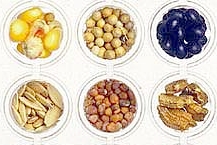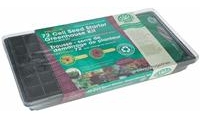 Seeds have such magical, hidden potential lying dormant within the seedpod. They come in all shapes, colors and sizes. Some are quick to start growing, others take some time.
Seeds have such magical, hidden potential lying dormant within the seedpod. They come in all shapes, colors and sizes. Some are quick to start growing, others take some time.
When you are purchasing seeds, it’s good to look for open-pollinated seeds, instead of hybrid seeds. According to the Primal Seeds website, “Hybrid seeds are the first generation offsprings of two distant and distinct parental lines of the same species. Seeds taken from a hybrid may either be sterile or more commonly fail to breed true, not incorporating and expressing the desired traits of the parent. The development of hybrid seed enabled the beginning of the commercial seed market. Farmers were persuaded to buy new hybrid seed each season, replacing the traditional practice of farm-saved seed, due to the “hybrid vigour” which can improve yields. Hybrid seed is also known as ‘high response’ seed. These seeds require fertilisers, herbicides, pesticides and lots of water to achieve their high yields.”
Hybrid seeds can lead to higher yields, but they also require more inputs in order to do so. Well, this is great for the agriculture companies, but not for the farmers or the rest of us! Now let’s take a look at open pollinated seeds. The Primal Seeds website explains, “Open-pollinated varieties are the traditional varieties which have been grown and selected for their desirable traits for millennia. They grow well without high inputs because they have been selected under organic conditions. These varieties have better flavour, are hardier and have more flexibility than hybrid varieties. Breeders cannot manipulate complex characteristics such as flavour as easily as they can size and shape. These seeds are dynamic, that is they mutate and adapt to the local ecosystem, as opposed to modern hybrids, which are static.”
The open-pollinated seeds can be grown organically with few inputs and they can be saved from year to year. The Council for Responsible Genetics has put together the Safe Seed Sourcebook to help people find places to buy open-pollinated seeds. Companies have to take the Safe Seed Pledge in order to be listed in the sourcebook.
I decided to buy seeds from the Victory Seed Company, which has taken the Safe Seed Pledge. On their website it says, “Unlike most seed companies that purchase all of their seed stock and repackage, we actually do farm and what seed we don’t raise here, is obtained from a network of carefully selected growers.” It was wonderful to go through their online catalog and read the descriptions for all the different types of vegetables, each with their own nuance. It was difficult to pick between the different varieties, so I ended up picking multiple types of tomatoes, peas, watermelons and peppers. For corn, cabbage, cucumber, eggplant, cilantro, fennel and a few other herbs and vegetables I picked just one variety. I spent about $48 altogether on buying seeds.
On a side note, it’s good to keep track of all your expenses in a spreadsheet, so you can see what you are spending most money on in the garden. Some things you will buy one time, like a fork and spade and other things like seeds you will buy every year.
 I bought several 72 cell seed starter kits from DoitBest which cost around $5 and includes 72 recyclable cell pack, greenhouse dome, carrying tray, and 4 quart seed starting mix. I also bought portable greenhouse which is a bit cheaply made, but helps to protect the little seedlings from the elements, especially when they are outside.
I bought several 72 cell seed starter kits from DoitBest which cost around $5 and includes 72 recyclable cell pack, greenhouse dome, carrying tray, and 4 quart seed starting mix. I also bought portable greenhouse which is a bit cheaply made, but helps to protect the little seedlings from the elements, especially when they are outside.
I emailed Josh the list of seeds I had purchased and he sent back a schedule of when the seeds should be planted and whether they should be planted in the seed starter kits or directly into the ground.
The seedling trays came with seed starting mix made from coir from coconut, so I just had to add water and the seed starter mix expanded. I carefully planted the seeds, covered the tray with the greenhouse dome and placed them on top of the refrigerator. Now it was time to just wait and watch. Slowly the different seeds started to grow into little seedlings. I wrote down where I planted what seeds on pieces of masking tape and stuck those onto the tray. I also created a spreadsheet to keep track of the seeds I planted in specific cells and what date I planted them. I was quite meticulous at this stage of the process. Later when the seeds were transplanted I wasn’t as careful, so now I don’t know specifically what variety a particular tomato or pepper seedling is.
Here are some of the lessons I learned growing from seeds. This is my first year growing from seeds, so all you experienced gardeners please share your tips because these may not be true based on your experience.
1. Don’t let the seedlings get too leggy.
This means transplant them when they get big enough, so they don’t start getting tall and thin. These seedlings have a tough time surviving when they are transplanted.
2. Hardening off seedlings is hard work.
To keep moving seedlings around from inside to outside for a few hours a day is not easy. They need to get acclimated to the outside, but it’s hard to achieve the perfect balance in giving them enough exposure to allow them to survive outside. Only some collard greens, basil, tomato, onion and pepper seedlings were able to make it after they were transplanted. The rest of the little seedlings were not strong enough to survive…
3. Some things grow well directly in the soil.
I have had such wonderful luck growing peas, corn, cucumbers, sunflowers and a few other things by planting them directly into the prepared beds.
4. Consider buying some seedlings from the farmers market.
I bought some tomato, pepper, eggplant, cucumber, thai basil and a few other herbs as seedlings from the farmers market. They are flourishing. They have a head start compared to my little seedlings. a friend of mine said that she prefers to buy seedlings for tomatoes and peppers because she wants different varieties, instead of the same varieties she would get by buying a pack of seeds.
Share your knowledge and experience growing from seed.
– Where do you buy your seeds and why?
– What are your favorite seeds to buy?
– Do you have any tips for hardening off seedlings and transplanting them?
– What seeds do you prefer to plant directly into the soil?
– Any other seed tips?